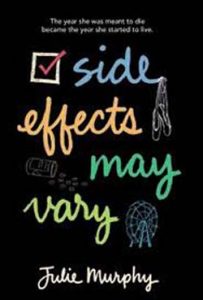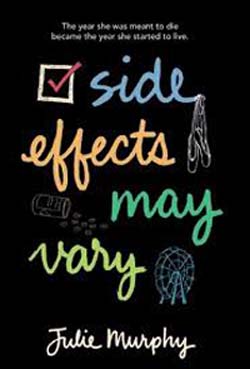[This post is the first in a six-part series of Book Reviews of books by some of our 2016 Midwest Writers faculty. The MWW interns wrote the reviews as one of their assignments for the Ball State University class “Literary Citizenship in a Digital Age,” taught by MWW Director Jama Kehoe Bigger.]
“I knew what this looked like. It looked like I was using Harvey. But here was the reality of the situation: the minute my life went from semipermanent to most likely temporary, I decided to latch on to everything in my world that had always been permanent, and for me, Harvey was so permanent he was concrete.”
In Julie Murphy’s first novel Side Effects May Vary, childhood best friends Alice and Harvey find themselves together again after Alice is diagnosed with leukemia. Divided between Alice and Harvey’s perspectives in chapters titled “then” and “now,” the novel follows the two on every path of Alice’s journey with cancer, from the beginning of high school and her revenge-filled kick-the-bucket list to the other side, where Alice learns she’s in remission.
 But is remission the good news it should be? For Alice, who was preparing to die, the situation is bittersweet as she must now deal with the repercussions of her actions and face the realities of her relationship with Harvey, especially as he struggles with his feelings for her, reflecting, “But, really, I loved her, and that hurt the worst of all because I was tired of being her debris.” Will she lose the best friend she finally connected with again when she was dying? Or will she find a way to adjust to truly living once more without pushing Harvey and his love away?
But is remission the good news it should be? For Alice, who was preparing to die, the situation is bittersweet as she must now deal with the repercussions of her actions and face the realities of her relationship with Harvey, especially as he struggles with his feelings for her, reflecting, “But, really, I loved her, and that hurt the worst of all because I was tired of being her debris.” Will she lose the best friend she finally connected with again when she was dying? Or will she find a way to adjust to truly living once more without pushing Harvey and his love away?
Murphy has crafted narrators that both fight and balance each other as they struggle to find their footing in their own past and present. Alice’s narration is particularly polarizing, allowing for Harvey’s emotions to inform the reader as Alice breaks down both the manic pixie dream girl trope and the interplay of likable and realistic narrators, as she describes, “I was rotten on the inside, and I didn’t know if that had happened over time or if it had always been so.” While the novel hinges on Alice’s diagnosis, the real meat of the plot concerns the very side effects of the diagnosis, pre- and post-remission, and how it impacts each character as they collide with Alice and Harvey’s story.



